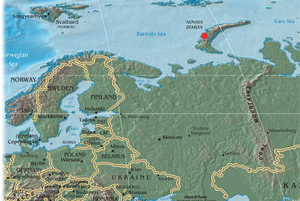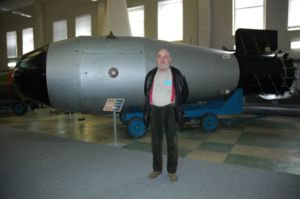Tsar Bomba
2008/9 Schools Wikipedia Selection. Related subjects: Military History and War
| RDS-220 | |
|---|---|
 The Tsar Bomba mushroom cloud |
|
| Type | Thermonuclear weapon |
| Place of origin | Soviet Union |
| Production history | |
| Number built | 1 |
| Specifications | |
| Weight | 27 tonnes |
| Length | 8 meters |
| Diameter | 2 meters |
|
|
|
| Blast yield | 50 megatons |
Tsar Bomba (Царь-бомба, literally " Emperor Bomb") is the Western name for the RDS-220 hydrogen bomb (codenamed "Иван" (Ivan) by its developers) — the largest, most powerful nuclear weapon ever detonated. Developed by the Soviet Union, the bomb was originally designed to have a yield of about 100 megatons of TNT; however that was reduced by half in order to limit the amount of nuclear fallout that would result. Two bombs were built, a mock bomb and the real bomb, with the real bomb being tested on October 30, 1961, in the Novaya Zemlya archipelago. Despite testing, the weapon never entered service; it was simply a demonstration of the capabilities of the Soviet Union's military technology at that time. The mock bomb was stored in the Russian Nuclear Weapons Museum in Sarov.
Origins
Soviet Premier Nikita Khrushchev initiated the project on July 10, 1961, requesting that the test take place in late October, while the 22nd Congress of the CPSU was in session.
The term "Tsar Bomba" was coined in an analogy with two other massive Russian objects, the Tsar Kolokol, the world's largest bell, and the Tsar Pushka, the world's largest howitzer. Although the bomb was so named by Western sources, the name is now widely used in Russia.
The Soviet Union used it as a deterrent to the United States during the Cold War. Khrushchev approved of the bomb's development during a very tense time; construction of the first Berlin wall began on August 13, 1961. Moreover, France was just emerging as the second Western European nuclear force on February 13, 1960 when Gerboise Bleue was successfully completed. The USSR had ended a de facto moratorium on nuclear tests (which lasted for nearly three years) and was about to deploy nuclear weapons in Cuba, which led to the Cuban Missile Crisis; in response to the U.S. deployment of nuclear weapons in Turkey.
In a speech to the United Nations General Assembly about the test, Khrushchev used the Russian idiom "show somebody Kuzka's mother", which means "to show who's the boss". Because of this, sometimes the weapon is referred to as "Kuzka's mother" (Кузькина мать) in Russian sources.
Design
The Tsar Bomba was a three-stage hydrogen bomb with a yield of about 50 megatons. This is equivalent to ten times the amount of all the explosives used in World War II combined. A three-stage H-bomb uses a fission bomb primary to compress a thermonuclear secondary, as in most H-bombs, and then uses energy from the resulting explosion to compress a much larger additional hydrogen thermonuclear stage. However, there is evidence that the Tsar Bomba had a number of third stages rather than a single very large one.
The initial three stage design was capable of approximately 100 Mt (Megatons), but at a cost of too much radioactive fallout. To limit fallout, the third stage, and possibly the second stage, had a lead tamper instead of a uranium-238 fusion tamper (which greatly amplifies the reaction by fissioning uranium atoms with fast neutrons from the fusion reaction). This eliminated fast fission by the fusion-stage neutrons, so that approximately 97% of the total energy resulted from fusion alone (as such, it was one of the "cleanest" nuclear bombs ever created, generating a very low amount of fallout relative to its yield). There was a strong incentive for this modification since most of the fallout from a test of the bomb would fall on populated Soviet territory.
The components were designed by a team of physicists which was headed by Academician Julii Borisovich Khariton and included Andrei Sakharov, Victor Adamsky, Yuri Babayev, Yuri Smirnov, and Yuri Trutnev. Shortly after the Tsar Bomba was detonated, Sakharov began speaking out against nuclear weapons, which culminated in him becoming a dissident.
The test
The Tsar Bomba was flown to its test site by a specially modified Tu-95V release plane which took off from an airfield in the Kola peninsula, flown by Major Andrei E. Durnovtsev. The release plane was accompanied by a Tu-16 observer plane that took air samples and filmed the test. Both aircraft were painted with a special reflective white paint to limit heat damage.
The bomb, weighing 27 tonnes, was so large (8 meters long by 2 m in diameter) that the Tu-95V had to have its bomb bay doors and fuselage fuel tanks removed. The bomb was attached to an 800 kilogram fall-retardation parachute, which gave the release and observer planes time to fly about 45 km from ground zero.
The Tsar Bomba detonated at 11:32 a.m. on October 30, 1961 over the Mityushikha Bay nuclear testing range (Sukhoy Nos Zone C), north of the Arctic Circle on Novaya Zemlya Island in the Arctic Sea. The bomb was dropped from an altitude of 10,500 m; it was designed to detonate at a height of 4,000 m over the land surface (4,200 m over sea level) by barometric sensors.
The original U.S. estimate of the yield was 57 Mt, but since 1991 all Russian sources have stated its yield as 50 Mt. Khrushchev warned in a filmed speech to the Communist parliament of the existence of a 100 Mt bomb (technically the design was capable of this yield). The fireball touched the ground, reached nearly as high as the altitude of the release plane, and was seen and felt 1,000 km away. The heat from the explosion could have caused third degree burns 100 km away from ground zero. The subsequent mushroom cloud was about 60 km high (nearly seven times higher than Mount Everest) and 30–40 km wide. At its peak it is well over 41 miles tall, and 27 miles thick. The explosion could be seen and felt in Finland, even breaking windows there. Atmospheric focusing caused blast damage up to 1,000 km away. The seismic shock created by the detonation was measurable even on its third passage around the Earth. Its Richter magnitude was about 5 to 5.25.
Since 50 Mt is 2.1×1017 joules, the average power produced during the entire fission-fusion process, lasting around 39 nanoseconds, was about 5.4×1024 watts or 5.4 yottawatts. This is equivalent to approximately 1.4% of the power output of the Sun.
The detonation of Tsar Bomba is the single most physically powerful device ever utilized throughout the history of humanity. By contrast, the largest weapon ever produced by the United States, the now-decommissioned B41, had a predicted maximum yield of 25 Mt, and the largest nuclear device ever tested by the U.S. ( Castle Bravo) yielded 15 Mt (due to a runaway reaction; the design yield was approximately 5 Mt). For comparison, the asteroid impact which formed the Chicxulub Crater, was an event larger than Tsar Bomba's yield by some six orders of magnitude; it released an estimated 500 zettajoules (5.0×1023 joules) of energy, approximately 100 teratons of TNT, on impact.
Fifty megatons of 1.654g/cm3 TNT would be about 30,230,000 cubic metres (1,067,000,000 cubic feet), or roughly a cube 300 metres (1000 feet) to a side.
Analysis
The weight and size of the Tsar Bomba limited the range and speed of the specially modified bomber carrying it and ruled out its delivery by an ICBM (although on December 24, 1962, a 50 Mt ICBM warhead developed by Chelyabinsk-70 was detonated at 24.2 megatons to reduce fallout). In terms of physical destructiveness, much of its high yield was inefficiently radiated upwards into space. It has been estimated that detonating the original 100 Mt design would have released fallout amounting to about 25 percent of all fallout emitted since the invention of nuclear weapons. Hence, the Tsar Bomba was an impractically powerful weapon. The Soviets decided that such a test blast would create too great a risk of nuclear fallout and a near certainty that the release plane would be unable to reach safety before detonation.
The Tsar Bomba was the culmination of a series of high-yield thermonuclear weapons designed by the USSR and U.S. during the 1950s (examples include the Mark-17 and B41). Such bombs were designed because:
- The nuclear bombs of the day were large and heavy, regardless of yield, and could only be delivered by strategic bombers. Hence yield was subject to dramatic economies of scale;
- It was feared that many bombers would fail to reach their targets because their size and low speed made detection and interception easy. Hence maximizing the firepower carried by any single bomber was vital;
- Prior to satellite intelligence, each side lacked precise knowledge of the location of the other side's military and industrial facilities;
- A bomb dropped without benefit of advanced inertial navigation systems could easily miss its intended target by six kilometres or more. Parachute retardation would only worsen the bomb's accuracy.
Thus certain bombs were designed to destroy an entire large city even if dropped five to ten kilometers from its centre. This objective meant that yield and effectiveness were positively correlated, at least up to a point. However, the advent of ICBMs accurate to 500 meters or better made such a design philosophy obsolete. Subsequent nuclear weapon design in the 1960s and 1970s focused primarily on increased accuracy, miniaturization, and safety. The standard practice for many years has been to employ multiple smaller warheads ( MIRVs) to " carpet" an area. This is believed to result in greater ground damage.

